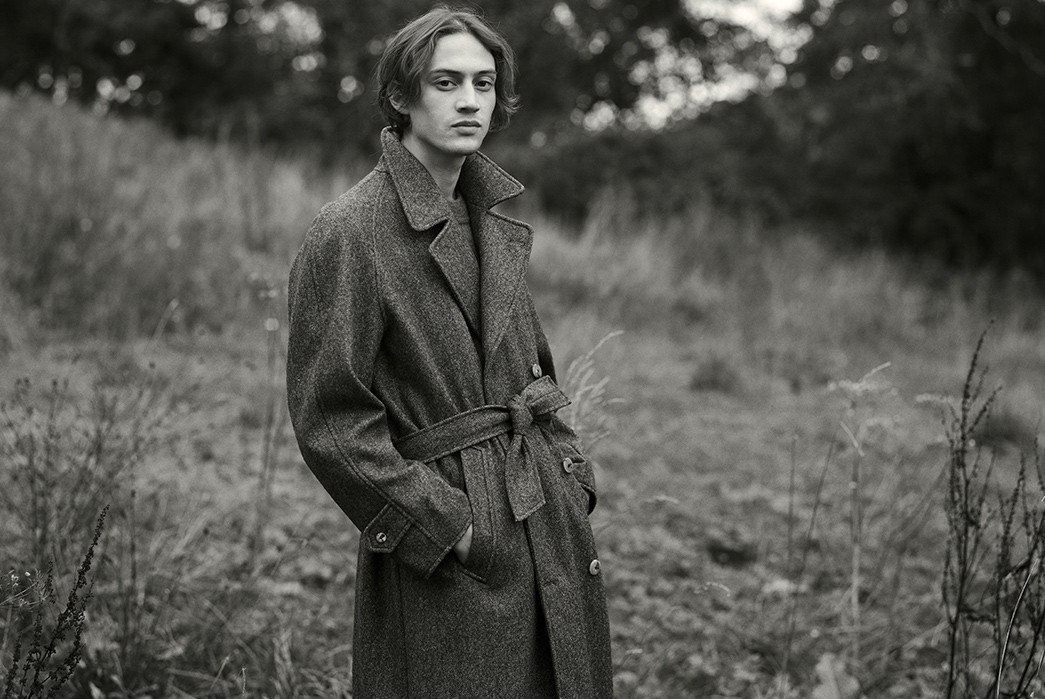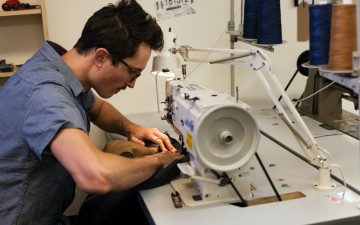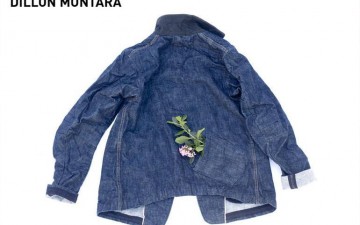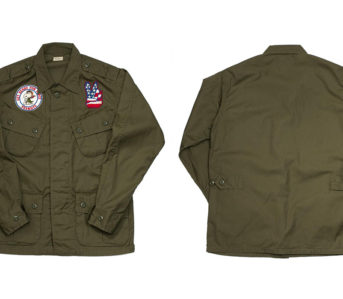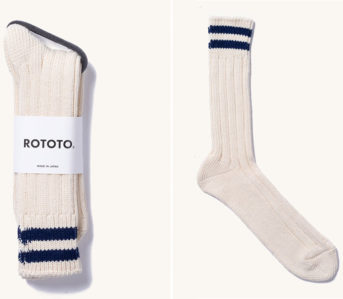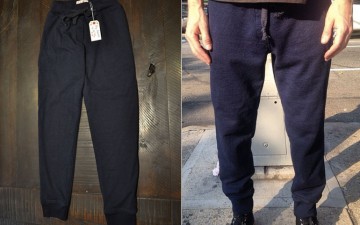Tricoterie du Val de Saire sits on a corner in the tiny French village Cotentin. Its founders, Monsieur and Madame Hyver, have been knitting experts since the 1960s and relocated their manufacturing business here from Paris in the late 70s.
Inside there are walls lined with garment patterns, a collection of specialist machines operated by a local team and a kaleidoscopic offering of yarns. It’s exactly as you might imagine a small-scale atelier to be in rural Normandy—surrounded by rustic cottages, farmhouses and fields, and it’s just one of the makers that designer De Bonne Facture has hand-picked to cut and make its clothes. The workshop’s credentials feature on the tags of every garment it has turned out for the Parisian label, with a more detailed description in its dedicated ‘Ateliers’ information online.
In an industry as secretive about its production as the fashion world is, showcasing the people involved in manufacturing processes can feel like quite the radical act, but it’s a pillar that Déborah Neuberg won’t compromise on, and one of the reasons she founded De Bonne Facture in 2013. Since then, she has been slowly weaving a network of makers across Europe that specialize in everything from shirtmaking to leatherwork.
There’s Mr Stefan Vanic near Paris, a coatmaker who learned the craft from his parents; Mr Hervier in central France whose tailoring know-how has been passed down through three generations; and Ms Cristina Traversi in Emilia-Romagna, Italy, whose knitwear expertise is second-to-none, to name just a few.
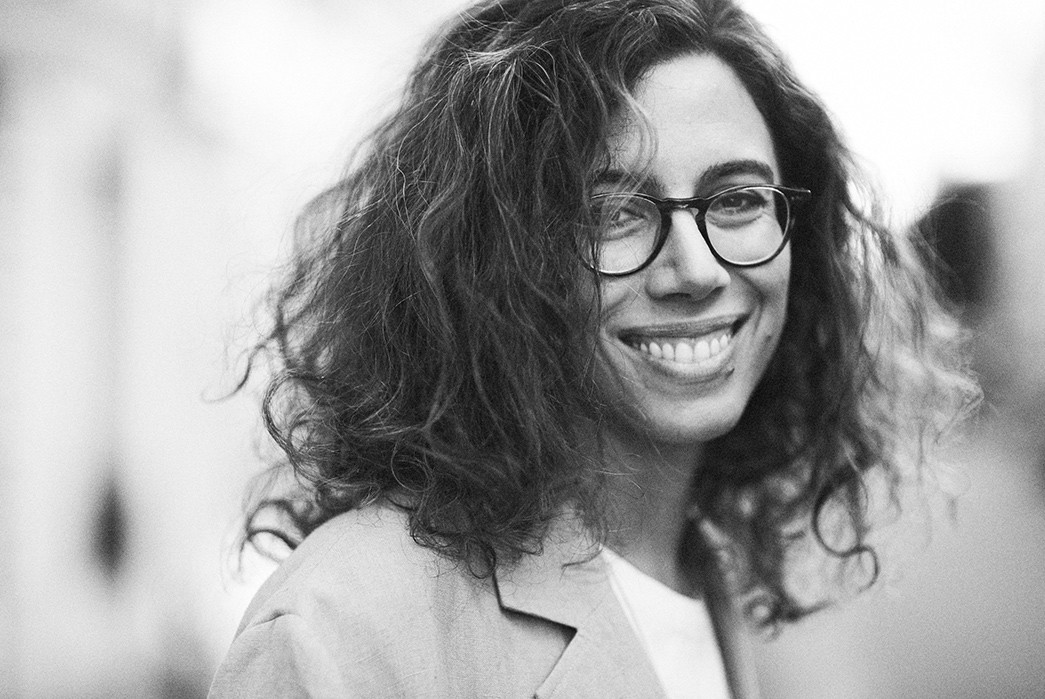
The brand’s founder, Déborah Neuberg
De Bonne Facture, which takes its name from a term used to describe works of quality, en français, is about making exactly that. Its clothes are quiet—both in their appearance and impact on the environment, and there’s a strong focus on timelessness, longevity and the tactile beauty of natural materials. There are no colossal differences from season to season, just nuanced details, traceability and the promise that every item has been made by people who are treated and paid fairly.
Prior to this, a stint in Hermès’ world-renowned silk department and a relocation to Shanghai for a production role at large-scale French underwear brand offered Déborah a glimpse at the expertise of manufacturers around the world. All of whom remained nameless and faceless to customers buying the products they’d made.
“From my first experiences in fashion, I felt that the name of the brand took most of the space in people’s minds… it’s a very complex, opaque industry” Déborah explains. “I saw that some of these makers were really highly qualified, had their own identities, craftsmanship, were in the place they were in for a reason—because of the climate there, or some kind of tradition or industrial culture—and there was a culture of making. Some makers actually uphold that type of craftsmanship, so I thought it was a real shame that they were put in the shade and that the only information that the client would get is the ‘made in’ label”.
Her rebuttal? A project to create a carefully considered capsule wardrobe using only natural fabrics and, at the same time, reconnect with regional makers in France. It wasn’t easy—finding local specialists in an industry notorious for off-shoring required plenty of research, word-of-mouth, and trips to the countryside where many are based.
The label has quietly grown over the last seven years thanks to a steady stream of interest from stockists in Japan and Europe, solidifying its reputation for classic menswear infused with flavours of workwear and heritage clothes.
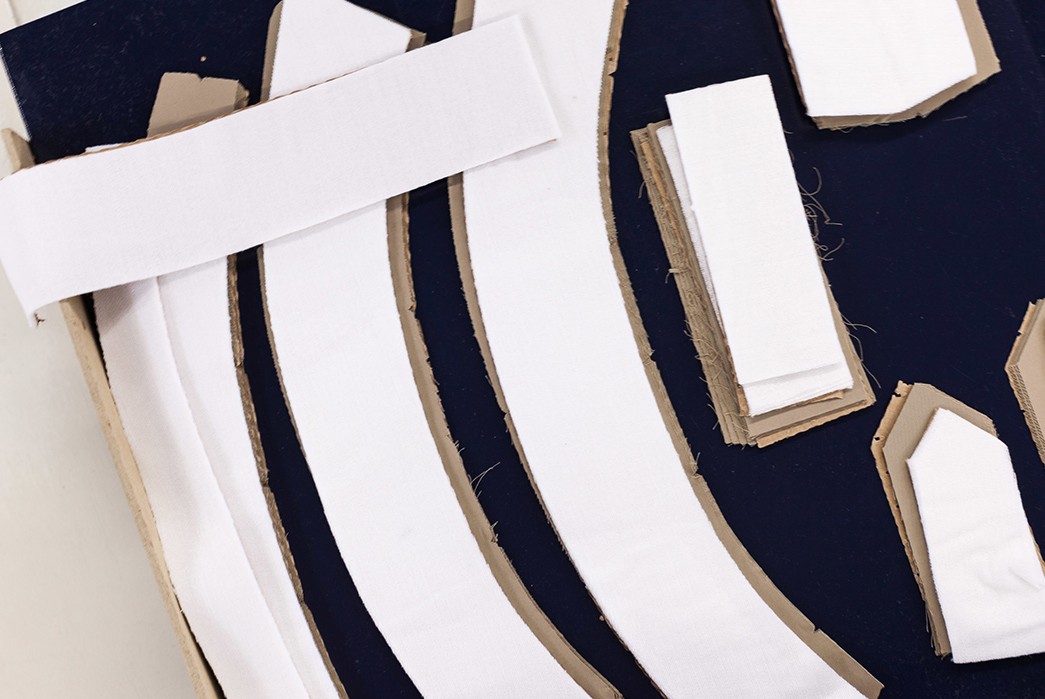
Pattern pieces and fabric ready for sewing at Hervier Productions, one of the brand’s manufacturing partners, in Châtillon-sur-Indre, France
Still, De Bonne Facture is by no means a large operation yet, so I wonder if Déborah has been forced to alter her design and sourcing processes to accommodate this more restrained approach to fashion. The answer is a complex one;
“In a way, we work like a traditional designer—we put out a collection, we have inspiration and a moodboard, we design new clothes every season. The difference is that because we have all of these constraints, you know—we want to work with this maker and not this maker, and we want to make sure this fabric is like this or that, it’s much more constraining on the creative process. Rather than… creating a collection from any fabrics, from any inspiration—in bigger houses, the fabric studio will just take everything and there’s no direction. The process here is a little different.”
There’s no doubt that a background in business and lifelong desire to be an entrepreneur have set her up well to convince mills and makers to produce the limited batches that a brand of such size requires.
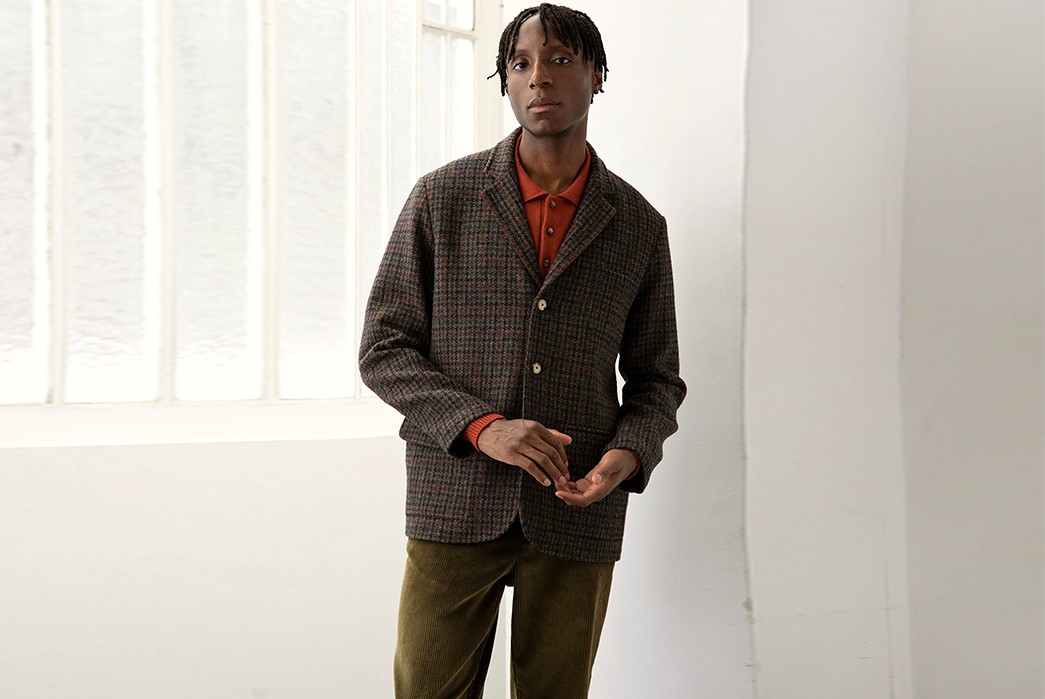
Blazer from Édition 15 cut from Harris tweed
On the subject of materials and influences, it’s clear just how much thought Déborah puts into both when we discuss Édition 15, the brand’s latest collection. There’s a particular photo of Jean-Michel Basquiat which was the starting point for much of the range—she says images of artists and musicians in the comfort of their studios always offer the most inspiration. This season sees De Bonne Facture continue to use all-natural and often rare materials, and, despite pushing the price point up, it’s these special pieces that have elicited the most enthusiastic responses.
The line-up is awash with heritage fabrics, like Harris Tweed straight from Scotland’s Outer Hebrides, and corduroys and moleskins commonly associated with traditional menswear—only cut in a cleaner, modern shape. Happily, the brand has added to its offering of undyed fibers too—it’s been a focus for a while now, with a herringbone fabric from last season (woven from two different shades of untouched wool) setting a beautiful example for what can be achieved without dye.
This new collection includes Pecora Nera®, a distinctive dark merino wool sourced from a New Zealand breeder whose mission is to reintroduce the use of black sheep’s wool.
“It’s a very interesting story because a long time ago… when breeding became more industrial in order to make more clothing in bigger quantities, farmers started to privilege white sheep because the wool was more standardised and easier to dye. That’s how sheep bred for the fashion industry and clothing became white, and how black sheep were supposed to be the bad ones in the herd,
“These farmers in New Zealand have been restarting the breeding of black sheep and making these amazing refined wools. They come in an undyed range, from a beige and taupe to very very dark brown. It’s really beautiful. We’ve worked with that wool with a bouclé finishing.”
This is just part of the brand’s commitment to more dignified and accountable material sourcing. Many of the fabrics used in its collections are organic, and much of the wool is mulesing-free—an assurance that every sheep has been spared a painful procedure of skin removal to prevent flystrike.
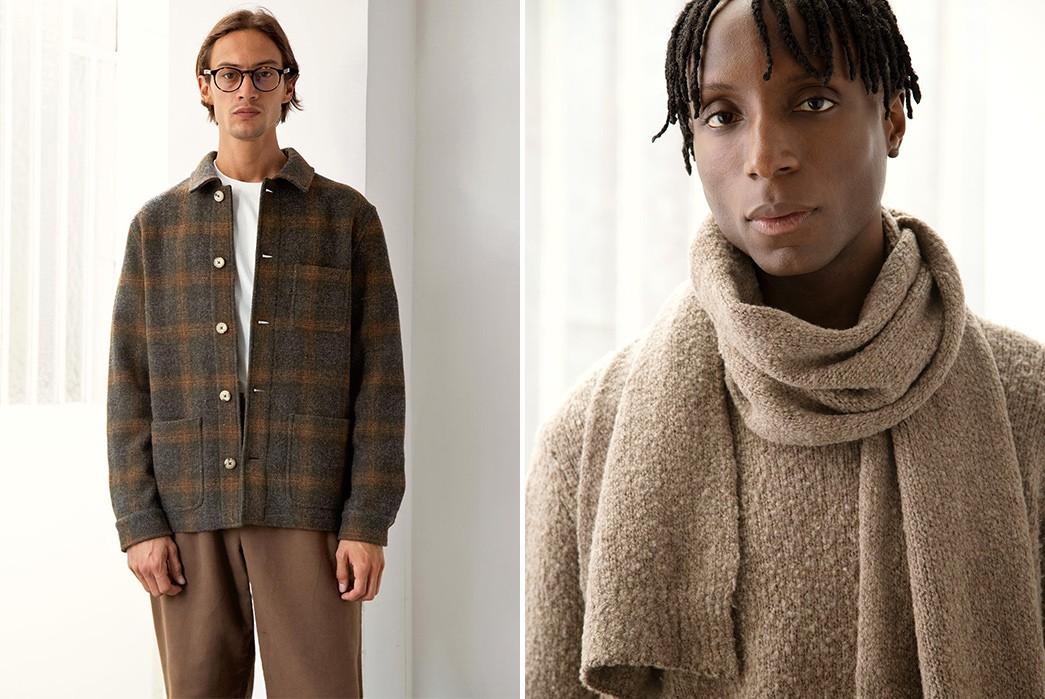
Washed virgin wool work jacket and Pecora Nera® sweater and scarf from collection Édition 15
Later, when we talk about the meaning of sustainability, it becomes clear just how much more complex these requirements can make the business.
“It’s a process that you have to be engaged in, and make your choices and explain them. And, you know, try to make choices that are better, ecologically, socially, durability-wise, and be willing to question yourself on your choices at every step and work hard, because it’s a lot of work to be asking questions about traceability to suppliers.
“When we make a choice, we have to ask so many questions in order to check that it’s compliant with what we do that actually, we’re setting ourselves back sometimes compared to other brands that don’t think about that and have a lighter process—who don’t care about where it’s made and then the product ends up maybe very desirable, but cheaper.”
Déborah believes that adopting a less individualistic mindset is the way forward for the clothing and textile industries. Without more influential labels pushing for better practices, she explains, things like ethically made fabrics won’t become readily available on a small scale.
“When we request, for instance, mulesing-free wools from some high-end Italian suppliers [whose businesses] rely a lot on huge fashion groups, as long as mulesing-free is not made a best practice in the industry, these suppliers will ask us for pretty high minimums that we cannot afford, in order to get us access to this kind of wool. So if the industry as a whole, especially the bigger players, doesn’t start to do that because they believe that’s the right way to go then we won’t have access to it.”
Encouraging collaboration and dialogue between brands of all sizes is part of the reason why she sits on the French Federation of Fashion and of Ready-to-Wear Couturiers and Fashion Designers’ Paris syndicate board. There, they hold workshops and salons on important issues, including sustainability. It’s a significant (and rare) opportunity to exchange ideas with some of fashion’s behemoths that Déborah seems hopeful will affect some change in the future.
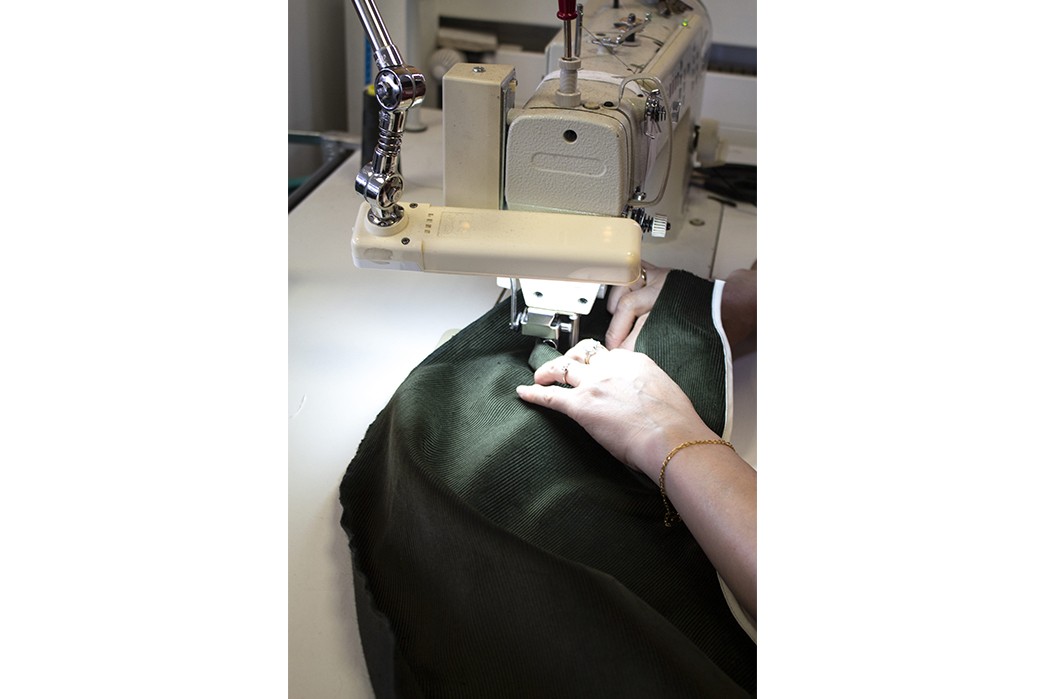
Garments underway at manufacturing partner Atelier Masla in Paris, France
Of course, it’s not lost on either of us what a strange world we’re living in at the time of our chat—this interview would’ve been the only excuse I needed to nip over to Paris were we not in the middle of a global pandemic. Instead of a trip on the Eurostar (and as many croissants as I could eat), I’ve settled for a Google Meet video call from dreary London, though its remoteness does nothing to detract from the impression I get of Déborah’s strength of purpose.
The sorts of challenges that De Bonne Facture might have faced in the ‘before-time’ must have shifted now, right?
“For us as a smaller brand, because of the virus, we’ve been challenged because we rely a lot on our [wholesale] retailers to survive and to develop ourselves. So there’s been a huge setback in that realm. And now we’re facing questions on how to develop our digital business and become more independent of those retailers, who supported us and enabled us to be in all these different markets and talk to people who are interested in our work. It’s a very challenging time for everyone. I think one of the big challenges the industry is facing is the digitalization of many processes, [particularly] wholesale processes, because we’re not showing at trade shows anymore. And also how to reach customers through retail and digital.”
In the end, though, while our current state of lockdown might be transient, clothes that are made well and responsibly are not—cared for properly, that undyed merino wool coat could hang in your wardrobe long enough to become a family heirloom.

